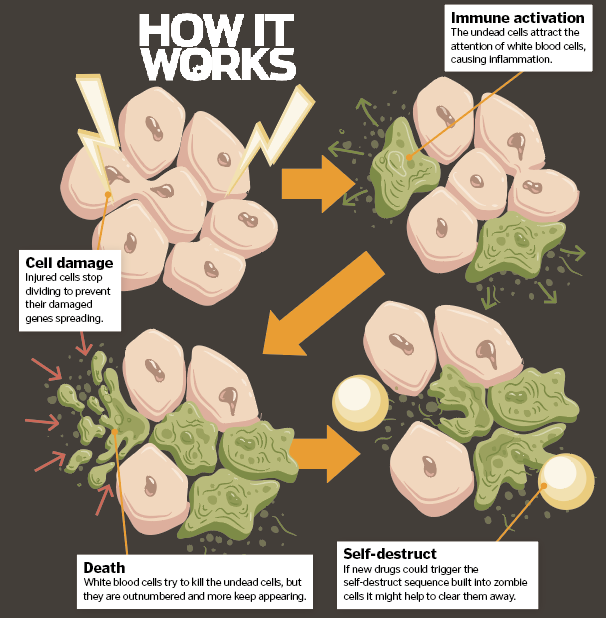The lives of undead Cells
by Scott Dutfield · 23/10/2019

As we age, our bodies clog up with zombie cells that just won’t die
Cells have a built-in safety switch that turns them off when they start to get old. They stop dividing, entering a quiet retirement period that scientists call senescence. The old cells send out signals to the immune system, letting it know that they’ve reached the end of their lives. Then they wait patiently for white blood cells to arrive and shut them down.
As we get older and more cells enter their twilight years, the immune system can’t always keep up with demand. As more and more cells cross over the threshold, the white blood cells get overwhelmed and they stop responding. Undead cells start to build up in tissues, still alive but unable to do their jobs. These zombie cells keep sending out distress signals in the hope that the immune system will come, but all this does is inflame the surrounding tissues. This harms nearby cells, which contributes to ageing.
Scientists found that clearing the undead cells in mice helps to kick-start tissue repair, reversing signs of ageing. Now pharmaceutical companies are racing to find new drugs that can help the immune system to eliminate the undead cells in our own bodies. These zombies have one major weakness – an in-built self-destruct sequence called apoptosis. We just need to find a drug that can push the button and set it off.
Zombie killers
How can we get rid of the undead cells clogging up our bodies?
What is senescence for?
Senescence is a pre-programmed state that cells can trigger if they’ve started to go wrong. It puts them safely into rest mode, where they can no longer make copies of themselves, preventing more faulty cells appearing inside the body. Not only does this keep organs and tissues working as normal, it also helps to protect against cancer. One of the hallmarks of cancer cells is that they ignore instructions to stop dividing and carry on replicating forever.
Senescence also happens to young, healthy cells, and it plays an important role in growing embryos. Halting cell division in certain places, while allowing it to continue elsewhere, helps to shape the body as it develops.
This article was originally published in How It Works issue 117, written by Laura Mears
For more science and technology articles, pick up the latest copy of How It Works from all good retailers or from our website now. If you have a tablet or smartphone, you can also download the digital version onto your iOS or Android device. To make sure you never miss an issue of How It Works magazine, subscribe today!





